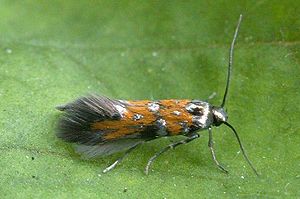Gelechioidea
| Gelechioidea | ||||||||||
|---|---|---|---|---|---|---|---|---|---|---|

|
||||||||||
| Systematics | ||||||||||
|
||||||||||
| Scientific name | ||||||||||
| Gelechioidea | ||||||||||
| Stainton , 1854 |
The Gelechioidea is a superfamily of butterflies (Lepidoptera) comprising around 16,250 species in 1,425 genera .
It includes around 2500 species and subspecies in Europe . The animals are distributed worldwide, but are less common at higher altitudes. The types of the well-defined superfamily encompass a very wide range of different characteristics. The delimitation of some taxa within this group is still unclear.
features
The predominantly small to medium-sized moths reach forewing lengths of about two ( Siskiwita falcata ) to 35 millimeters ( Cryptophasa setiotricha ). Most species have a wing length of 5 to 15 millimeters. The group differs from the other superfamilies by an overlapping scaling on the dorsal surface of the proboscis , which, depending on the species, extends from the base to a maximum of half of the proboscis. Although this scaling also occurs in the superfamilies Pyraloidea and Choreutoidea , the former have paired tympanic organs at the base of the abdomen, the latter have bare, small, one- to two-segment maxillary palps . These characteristics do not occur in the Gelechioidea.
Other features that appear in most species of the Gelechioidea are scaly, four-membered maxillary palps that are either directed downward and parallel or overlapping with the base of the proboscis. The three-part labial palps are directed upwards, their third segment is elongated and pointed. The head is smoothly scaled, Jordanian organs (Chaetosemata) are not developed. The dorsal surface on the tarsi of the hind legs are long and slender. The antennae are mostly thread-like or ciliate and rarely combed or feathered.
distribution
The distribution of the individual families within the Gelechioidea varies greatly. For example, the Oecophorinae subfamily makes up most of the butterfly species in Australia and the second most in New Zealand , but is completely absent from Hawaii. The palm moths (Gelechiidae) are much more represented in North America, north of Mexico, than the rottenwood moths (Oecophoridae) and grass miners (Elachistidae), the subfamily Stenomatinae is very well represented with almost 1,100 species in the Neotropic , but only nine species occur in the Antilles .
In general, the representatives of the Gelechioidea are poorly researched compared to other groups of butterflies, with the exception of a few areas, so that it can be assumed that in the Nearctic, for example, only about 30% of the palm moths, 10% of the Scythridinae , 20% of the Coleophorinae , 25% of the Momphinae , 60 to 70% of the golden butterflies (Cosmopterigidae) and 30% of the grass miners are currently described. In the Neotropic , half of the Stenomatinae and less than 20% of the palm moths have been described; in sub- Saharan Africa , for example, more detailed studies of the palm moths and Lecithoceridae are only available in South Africa . In Australia only about half of the species of the Oecophorinae living there are recorded.
Way of life
Most members of the superfamily are nocturnal or crepuscular, but there are also some genera that are diurnal. These are often very vividly colored. Species distributed in the alpine and arctic regions can be diurnal, but are usually very dark in color. The larvae feed on dead or rotting plant and animal material; they have been found in practically every living plant species and even in living mammals. In most species, the larvae live protected in a web or in leaves that are spun together. Some species produce plant galls on roots or branches, are miners , or wear a self-made cover for protection. The pupation takes place mostly in the larval chamber where the doll can also be exposed. The pupa does not change its position, it remains there until the imago hatches .
The eggs are as a rule of the flat type, rarely they are of the upright type in species of the mini-sac carrier (Coleophoridae) and the Scythidinae. As a rule, they are deposited individually, with some species they are stung into flowers or deposited in crevices in the rock. With the exception of the Palearctic species, little is known about the pre-imaginal stages.
Systematics
- Amphisbatidae
- Autostichidae
- Batrachedridae
- Chimabachidae
- Deoclonidae
- Rottenwood moths (Oecophoridae)
- Glyphidoceridae
- Grass miners (Elachistidae)
- Lecithoceridae
- Lypusidae
- Mini bag carrier or bag carrier moth (Coleophoridae)
- Palm moths (Gelechiidae)
- Peleopodidae
- Magnificent butterfly (Cosmopterigidae)
- Schistonoeidae
- Stathmopodidae
- Xyloryctidae (with the subfamily Scythridinae )
literature
- Niels P. Kristensen: Lepidoptera, moths and butterflies . In: Maximilian Fischer (Ed.): Handbook of Zoology . 1st edition. tape 4 - Arthropoda: Insecta , volume 35. de Gruyter, Berlin / New York 1998, ISBN 3-11-015704-7 (English).
- Malcolm J. Scoble: The Lepidoptera: Form, Function and Diversity . Oxford University Press, Oxford 1995, ISBN 0-19-854952-0 (English).
Individual evidence
- ↑ Gelechioidea in Fauna Europaea. Retrieved December 27, 2009